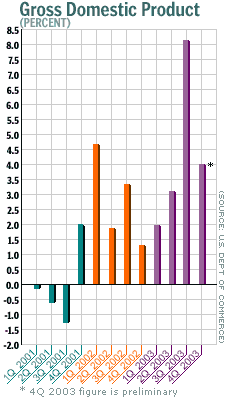NEW YORK (CNN/Money) -
The U.S. economy followed up a strong third quarter of 2003 with another healthy growth rate in the fourth quarter, the government said Friday, but the pace fell short of Wall Street estimates.
Gross domestic product (GDP), the broadest measure of economic activity, grew at a 4 percent annualized rate in the quarter after growing at an 8.2 percent pace in the third, the Commerce Department reported.

Economists, on average, expected GDP growth of 5 percent, according to Briefing.com. Given a recovery in U.S. exports, and expected strength in inventory rebuilding and government spending, some economists had hoped for a growth rate as high as 6 percent.
"This reflects a more subdued consumer, given that the pace of refinancing and stimulus eased off a bit in the fourth quarter," said Anthony Chan, chief economist at Banc One Investment Advisors. "Moving forward, it tells us that this economy is recovering at a nice but unrobust pace."
In all of 2003, GDP rose at a pace of 3.1 percent, compared with 2.2 percent in 2002.
U.S. stock prices were mixed in early trading after the report, helped by separate, stronger-than-expected readings on consumer confidence and Chicago-area manufacturing activity. Treasury bond prices were mostly higher, pushing yields -- which move opposite price -- lower.
Friday's GDP report was a preliminary number, based on incomplete data. It will be revised at least twice, possibly more.
Consumer spending, which makes up more than two-thirds of total GDP, rose at a pace of 2.6 percent in the fourth quarter, the Commerce Department said, compared with a rate of growth of 6.9 percent in the third quarter.
Tax rebates and the proceeds from a boom in mortgage refinancing helped fuel the strong consumption growth in the third quarter, but many economists expected spending to slow down in the fourth quarter, as the effect of those stimuli faded.
| Related stories
|

|
|
|
|
Consumer spending is expected to get another boost in the second quarter of 2004 from higher-than-usual tax-refund checks, as many companies apparently withheld too much money from employees' paychecks after last year's tax cut. An expectation of healthy consumer spending has led many economists to forecast a GDP growth rate of better than 4 percent this year.
But Friday's report suggests future consumption growth will have a lower-than-expected platform from which to rise or fall.
"This is something that people who keep raising their forecasts for 2004 GDP should be concerned about," said Paul Kasriel, research director at Northern Trust. "If households are going to stop spending, then businesses won't continue to spend."
The politics of GDP
President Bush, seeking re-election in November, has touted the strong economic growth rates of the second half of 2003 as vindication for the tax cuts he pushed in early 2003.
"America's economic recovery is now well underway thanks to the President's tax relief," Commerce Secretary Donald Evans said Friday.
But stronger growth has not yet translated into consistent hiring, and many liberals suggest Bush could have pushed for other kinds of tax cuts that were more stimulative.
Non-farm payrolls are still 2.3 million jobs smaller than they were when Bush took office in January 2001, meaning he could possibly be the first president since Herbert Hoover to end a full presidential term with a net loss of jobs, and Democrats took the opportunity on Friday to remind voters of that.
"Growth like this should be accompanied by rapid growth in jobs and wages, but neither has materialized this far into the recovery," said Rep. Pete Stark, D-Calif., the senior Democrat on the Senate Joint Economic Committee.
Businesses spend, but rebuild inventories slowly
Business spending grew at a healthy 6.9 percent pace, compared with a 12.8 percent annualized rate in the third quarter. Many economists believe that, if consumer spending is going to cool to a more normal pace, then economic growth will be led by increased business investment and -- hopefully -- hiring.
Anemic hiring has kept wage growth slow, also keeping a lid on inflation. The GDP report's personal consumption expenditure deflator, a key measure of consumer inflation closely watched by the Federal Reserve, rose at a paltry 0.7 percent rate in the fourth quarter and 1.2 percent in all of 2003.
With inflation at bay, the Federal Reserve decided Wednesday to keep its target for a key short-term interest rate at the lowest level in more than 40 years and promised to be "patient" in raising rates.
"The economy has some slack, and it needs to grow above trend for a while to take up that slack," said Joshua Feinman, chief economist with Deutsche Bank Asset Management. "Inflation not likely to be prob any time soon -- if it is a problem, it will be because it is too low."
Fourth-quarter GDP also got a boost from an improving international trade balance. Exports, which add to GDP, rose at a 19.1 percent pace, compared with 9.9 percent in the third quarter, more than offsetting an 11.3 percent pace of growth in imports, which subtract from GDP. The U.S. dollar's weakness in recent years has helped boost exports, making U.S. goods cheaper overseas.
A $6.1 billion improvement in business inventories also helped GDP, but wasn't as strong as analysts expected. Government spending at the federal and local level rose at a 0.8-percent pace in the quarter, compared with 1.8-percent in the third, also lower than some forecasts.
Many economists believe businesses will have to restock their depleted shelves after stronger than expected sales last year.
But others suggest that improvements in inventory-management technology -- including the wireless "radio frequency identification (RFID)" tags used by Wal-Mart (WMT: Research, Estimates) suppliers -- will allow businesses to carry leaner inventories. If that's true, then GDP will get less of a boost from inventories in 2004 than expected.
Excluding inventory growth, real final sales rose at a 3.4 percent pace in the quarter, compared with an 8.3 percent pace in the third.

|

